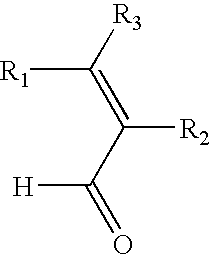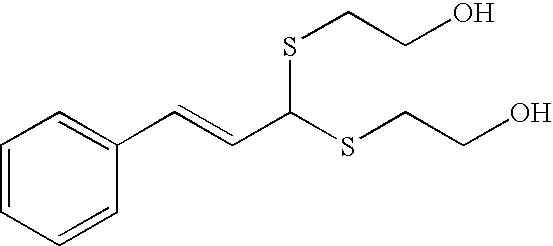Thiol/aldehyde corrosion inhibitors
a technology of corrosion inhibitors and aldehydes, applied in the field of corrosion inhibitors, can solve the problems of high cost of repairing or replacing corrosion damaged metal tubular goods and equipment, metal tubular goods are subject to corrosive fluids, and other equipment is often a problem,
- Summary
- Abstract
- Description
- Claims
- Application Information
AI Technical Summary
Benefits of technology
Problems solved by technology
Method used
Image
Examples
example 1
[0045]One method of forming thioacetals corrosion inhibitors of the present invention involves combining a cinnamaldehyde compound with a thiol compound in the presence of an acid. Sample 1 was formed by placing cinnamaldehyde in glacial acetic acid and adding 2.2 equivalents of thioethanol, 0.05 equivalents of ρ-toluenesulfonic acid was also added to the reactive mixture to speed up the reaction.
[0046]The thioacetals corrosion inhibitors were tested on metal coupons free of surface contaminants and scale. To ensure that the coupons were properly prepared, they were soaked in acetone to remove any material remaining on the metal from manufacturing and then visually inspected for burrs or other loosely attached metal. Next, the coupons were bead blasted using coarse glass beads to remove contaminants including oxidation products and material lodged in areas where the coupon surfaces may be irregular. The coupons were then used immediately.
[0047]To test the activity of the corrosion i...
PUM
| Property | Measurement | Unit |
|---|---|---|
| density | aaaaa | aaaaa |
| density | aaaaa | aaaaa |
| density | aaaaa | aaaaa |
Abstract
Description
Claims
Application Information
 Login to View More
Login to View More - R&D
- Intellectual Property
- Life Sciences
- Materials
- Tech Scout
- Unparalleled Data Quality
- Higher Quality Content
- 60% Fewer Hallucinations
Browse by: Latest US Patents, China's latest patents, Technical Efficacy Thesaurus, Application Domain, Technology Topic, Popular Technical Reports.
© 2025 PatSnap. All rights reserved.Legal|Privacy policy|Modern Slavery Act Transparency Statement|Sitemap|About US| Contact US: help@patsnap.com



